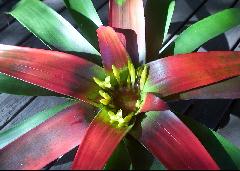
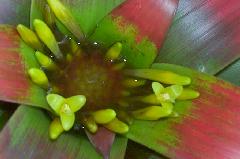
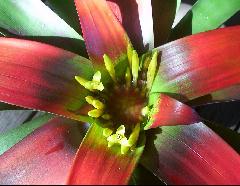
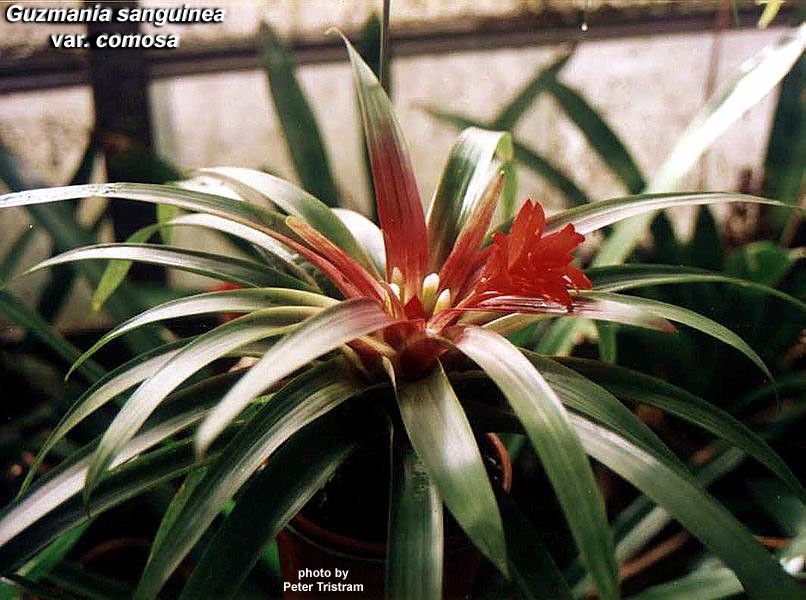

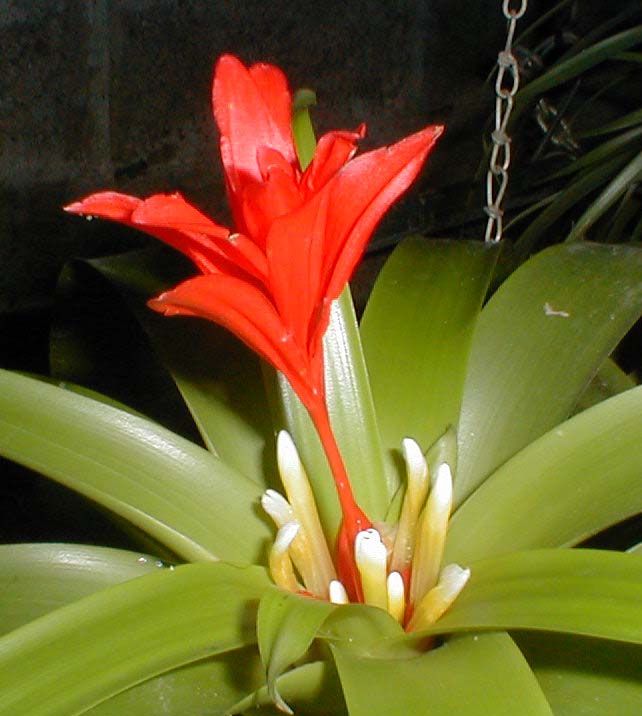
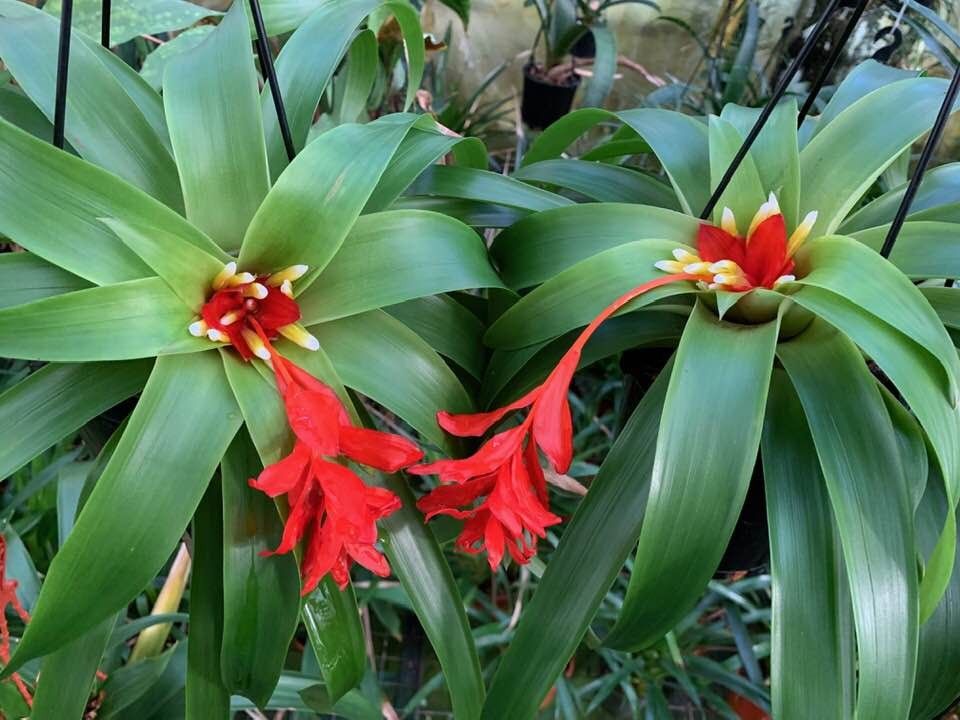
Guzmania sanguinea (Andre) Andre ex Mez, DC. Monogr. Phan. 9: 901. 1896.
Desc from S&D
Plant stemless.
Leaves in a cyathiform rosette;
sheaths scarcely broader than the blades, very densely brown-lepidote;
blades ligulate, all or only the inner ones bright red.
Scape none.
Inflorescence simple, corymbiform, 7-12-flowered, the involucral leaves shorter than the others but otherwise much the same.
Floral bracts exceeding the sepals, membranaceous;
flowers erect; pedicels slender.
Sepals elliptic, broadly obtuse, 17 mm long, short-connate, glabrous, even;
petals to 75 mm long, coherent in a slender yellow tube for most of their length, the blades spreading, broadly ovate.
Capsule acuminate, to 45 mm long.
Var. erecta Andre does not appear to belong to this species but cannot be identified with any other as yet because of the very poor material upon which it is based.
Caraguata sanguinea var. erecta Ed. Andre, Enum. Bromel., p. 5.
Detail from Bromeliaceae Andreanae, 81. 1889
Forma typo multo validior, caudice subrepente, crasso, foliis erectis breviter lanceolato-acutis, subtus multipunctulatis, scapo elongato robusto bracteis ovatis v. acuminato-acutis arcte invaginato, capitulis majoribus
A more robust variety of the type. It is distinguished by a thick creeping stem, upright leaves which are lanceolate and abruptly acute, covered below by small, dark purple spots. Its scape is coarse and long, 40 cm or more, densely covered with bractlike leaves, ovate or acuminate-acute and sheathed. Inflorescences larger.
Grows in humid forests in the southern Cordilleras of the Colombian Andes near Altaquer at 1000 m altitude. Fruiting in May. (Andre's Herbarium, no. 3369 bis.)
I have not seen any flowers of this plant. When examined under a magnifier, its foliage is spotted with innumerable dark violet dots which shall cause me to name it C. myriostigma, should future studies of the inflorescences allow me to establish it as a new species.
Notes
1. This taxon cannot be identified with any known species. Luther’s comment, “This is very doubtfully a variety of G. sanguinea and may be conspecific with G. fusispica Mez & Sodiro; regardless, the type and the only illustration are so poor that a positive identification is impossible.
2. C. myriostigma was never published and the provisional name for C. sanguinea var. erecta should it be determined to be distinct
3. This taxon was never formally transferred to Guzmania.
Guzmania sanguinea var sanguinea
Tillandsia sanguinea Andre, Tour du Monde 38: 367. 1879; nomen subnudum.
Caraguata sanguinea Andre, Revue Hort. 55: 468, fig. 95, pl. 1883.
Guzmania crateriflora Mez & Werckle ex Mez, Bull. Herb. Boiss. 11.5: 110.1905. Type. Costa Rica without further locality, Werckle 84 (B, B photo 1206/21-22).
Leaves to 4 dm long;
blades to 55 mm wide.
Floral bracts rounded and apiculate, flat.
Petal blades white to greenish yellow.
Type. Andre 3369 (holotype K, K photo 7462), Los Astrojos, Tuquerres to Barbacoas, Narino, Colombia, May 1876.
DISTRIBUTION. Epiphytic in forest, near sea level to 1050 m alt, Costa Rica, Colombia, Trinidad, Tobago, Ecuador.
COSTA RICA. Isla del Coco (Cocos Island), 18 Apr 1930, Svenson 322 (GH); 434 (GH). COLOMBIA. VALLE: Veneral, Rio Yurumangui, 1944, Cuatrecasas 15827 (VALLE); Agua Clara, Buenaventura to Cali, 6 Jun 1944, Killip & Cuatrecasas 38871 (US); caserio San Francisco, Rio Raposo, 12 May 1966, Orjuela 257 (US, VALLE). NARINO: Altaquer, 11 Nov 1946, Foster 2133 (GH). VENEZUELA: DISTRITO FEDERAL: Naiguata, 15 Aug 1970, Steyermark 103734 (VEN). TRINIDAD. Valencia, Pittendrigh 5 (GH); 1944,1243 (US); 1244 (US); Tamana, Pittendrigh 1306 (TRIN); 1311 (TRIN); 1531 (TRIN); Morne Bleu, 9 Mar 1955, Aitken s n (TRIN); Biche, Aitken s n (TRIN). TOBAGO. Roxborough, 31 Jul 1957, Aitken s n (US). ECUADOR. MANABI: Cerro Monte Cristi, 10 Aug 1962, Gilmartin 771 (US); 8 Sep 1963, 861 (US).
Guzmania sanguinea var brevipedicellata Gilmartin, Phytologia 16: 164. 1968.
Leaves mostly not over 20 cm long;
blades to 25 mm wide.
Floral bracts acute, to 22 mm long, subcucullate;
pedicels short.
Type. Gilmartin 888 (holotype US), near km 97, Duran to El Tambo, Canar, Ecuador , 22 Mar 1964.
DISTRIBUTION. Epiphytic in forest, 300-2100 m alt, Ecuador.
ECUADOR. CHIMBORAZO: Bucay, 4 jun 1962, Gilmartin 739 (US); without exact locality, Wagner s n (US). CANAR: Ducur, Cuenca to Guayaquil, Teuscher s n (US).
Guzmania sanguinea (Andre) Andre ex Mez var. comosa Luther, Selbyana 11: 54-7. 1989.
A typo G. sanguinea (Andre) Andre ex Mez sed bracteis florigeris grandis et apex inflorescentia elongatus sterilisque differt.
Type. Colombia; without specific locality, flowered in cultivation, 12 October 1980, H. E. Luther 407 (SEL, holotype).
Rosulate epiphyte.
Leaves to 40 cm long, the innermost bright red at anthesis.
Scape very short.
Inflorescence simple.
Floral bracts to 4 cm long, red to orange.
Pedicels slender, to 1.8 cm long.
Sepals to 2.2 cm long, pale yellow.
Corolla to 6 cm long, bright yellow tipped white.
Main axis of the inflorescence elongated above the flowers with a sterile tuft of floral bracts at the apex.
PARATYPE. Colombia; Dept. Valle, Agua Clara along highway from Buenaventura to Cali, l00 m, 6 June 1944, E. P. Killip & J. Cuartrecasas 38871 (US).
This spectacular variety has been in limited cultivation since the early 1960's and has been misidentified first as Guzmania eduardii Andre ex Mez and later as G. sanguinea var. erecta Andre. The latter is very doubtfully a variety of G. sanguinea and may be conspecific with G. fusispica Mez & Sodiro; regardless, the type and the only illustration are so poor that a positive identification is impossible.
Guzmania sanguinea var. comosa Harry E. Luther in J Brom Soc 39(5): 197-199, 204. 1989
Some bromeliads enjoy a lengthy period in cultivation before they are properly identified or described. Occasionally, species named from horticultural material have never been re-collected in the wild (e.g. Puya hortensis L.B. Smith, Billbergia buchholtzii Mez, and Wittrockia amazonica Baker L.B. Smith). The odd but attractive guzmania shown in figure 2 has been in and out of horticulture for nearly 30 years.
The first record of this taxon in cultivation appeared as a short article in the equally short-lived publication Bromeliad Papers published by Alex D. Hawkes in the late 1950s and early 1960s. Unfortunately it was misidentified. This first notice is reprinted in full (following a tradition set forth by its author) from volume 2, number 3, July 1960.
Guzmania eduardii. At the regular meeting of the Bromeliad Society of South Florida for July, the president of the organization, Nat DeLeon, brought an extremely unusual bromeliad for the exhibition table. A plant collected by him in Colombia, it has provisionally been determined as Guzmania eduardii Andre ex Mez. According to Smith's Bromeliaceae of Colombia (1957), this species has been gathered on several occasions in that country . Mr. DeLeon's specimen was a very pretty thing with broad foliage and a sunken cluster of proportionately large flowers with white petals. But the extraordinary thing about this plant was the "featherduster"-like structure sticking up out of the middle of the inflorescence, to a height of several inches. With a vivid scarlet stalk, its apical portion was set with a series of largish scarlet bracts, the purpose of which we were unable to fathom! Careful examination of this odd structure did not disclose any evidence of abortive flowers at the bases of these "aerial" bracts, as might have been expected. No mention of this condition is made in Dr. Smith's description of G. eduardii, and we know of no comparable structure elsewhere in Bromeliaceae.
This misidentification probably had its origin with a specimen at the Smithsonian Institution collected in Colombia in 1944 that was first determined as Guzmania eduardii Andre "aberrant." By the end of 1950, the identification had been changed to G. sanguinea (Andre) Andre ex Mez. As the specimen is rather incomplete there was certainly cause for confusion.
Apparently the DeLeon plant did not persist in cultivation.
The next appearance of this odd plant in print, and beautifully photographed, was on page 260, Vol. XXXI, (1981) of the Journal of the Bromeliad Society. This article by Jeffrey Kent stated that the plant had been collected above Tumaco in southwest Colombia. Here it was identified as the long-lost Guzmania sanguinea var. erecta Andre.
The type specimen and illustration of var. erecta are very poor, old, and shattered. It is impossible to clearly determine the relationships of this taxon but it is clearly not with Guzmania sanguinea because var. erecta has a scapose, short cylindric inflorescence. The overall habit suggests that it may be conspecific with G. fusispica Mez & Sodiro. The illustration taken from Bromeliaceae Andreanae, plate XVII (fig. 3) clearly contrasts Guzmania (Caraguata) sanguinea with its proposed variety.
Shortly before Mr. Kent's expedition, Franz Gruber of the nursery Orchideas S.A. in Colombia introduced a limited number of plants of this taxon into Florida. These were also identified as G. sanguinea var. erecta. They have remained in horticulture but have never been widely distributed because of their limited potential for asexual propagation. Evidently no one has attempted to grow them from seed.
Finally, after more than 44 years since its discovery (and nearly 30 since it was introduced to horticulture), this confusing plant has a name, Guzmania sanguinea var. comosa Luther, published in Selbyana, volume 11 ( 1989) . This new variety differs from the type of the species by its larger floral bracts, with the axis of the inflorescence elongated above the flowers, and with a sterile tuft of bracts at the apex.
All growers possessing this guzmania are urged to alter their tags.